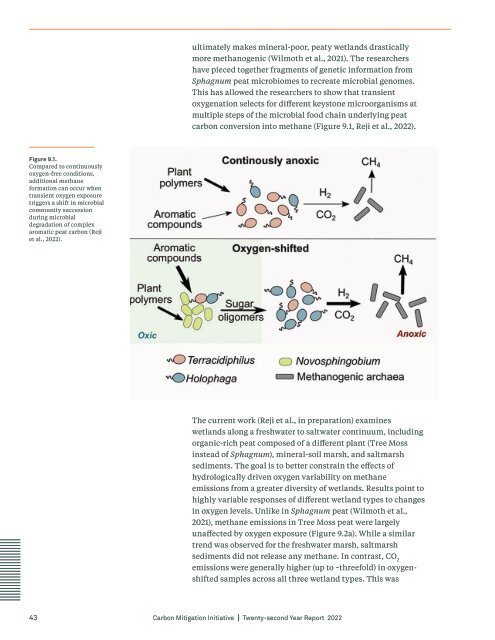CMI Annual Report 2022
You also want an ePaper? Increase the reach of your titles
YUMPU automatically turns print PDFs into web optimized ePapers that Google loves.
ultimately makes mineral-poor, peaty wetlands drastically<br />
more methanogenic (Wilmoth et al., 2021). The researchers<br />
have pieced together fragments of genetic information from<br />
Sphagnum peat microbiomes to recreate microbial genomes.<br />
This has allowed the researchers to show that transient<br />
oxygenation selects for different keystone microorganisms at<br />
multiple steps of the microbial food chain underlying peat<br />
carbon conversion into methane (Figure 9.1, Reji et al., <strong>2022</strong>).<br />
Figure 9.1.<br />
Compared to continuously<br />
oxygen-free conditions,<br />
additional methane<br />
formation can occur when<br />
transient oxygen exposure<br />
triggers a shift in microbial<br />
community succession<br />
during microbial<br />
degradation of complex<br />
aromatic peat carbon (Reji<br />
et al., <strong>2022</strong>).<br />
The current work (Reji et al., in preparation) examines<br />
wetlands along a freshwater to saltwater continuum, including<br />
organic-rich peat composed of a different plant (Tree Moss<br />
instead of Sphagnum), mineral-soil marsh, and saltmarsh<br />
sediments. The goal is to better constrain the effects of<br />
hydrologically driven oxygen variability on methane<br />
emissions from a greater diversity of wetlands. Results point to<br />
highly variable responses of different wetland types to changes<br />
in oxygen levels. Unlike in Sphagnum peat (Wilmoth et al.,<br />
2021), methane emissions in Tree Moss peat were largely<br />
unaffected by oxygen exposure (Figure 9.2a). While a similar<br />
trend was observed for the freshwater marsh, saltmarsh<br />
sediments did not release any methane. In contrast, CO 2<br />
emissions were generally higher (up to ~threefold) in oxygenshifted<br />
samples across all three wetland types. This was<br />
43<br />
Carbon Mitigation Initiative Twenty-second Year <strong>Report</strong> <strong>2022</strong>
















